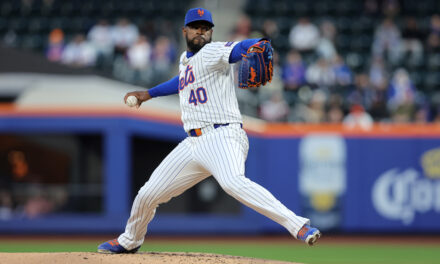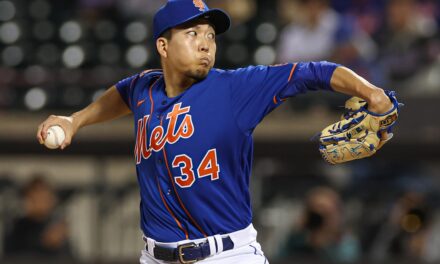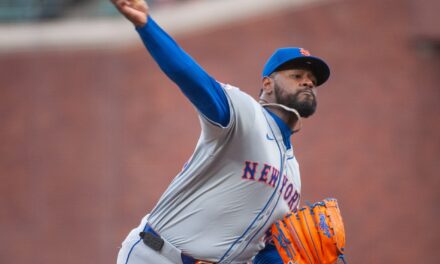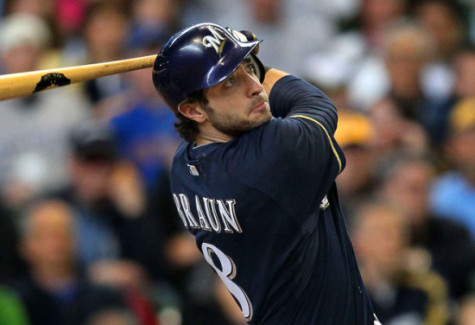
Last spring I interviewed Steve Kettmann for Metsmerized Online following the publication of his book “Baseball Maverick,” and one of the questions involved whether he’d noticed any indication that the Mets front office was adjusting to a post-steroid era. I thought his response was interesting.
MB: Given this front office’s statistical predilections, have there been any efforts to establish post steroid era norms to your knowledge?
Steve Kettmann: I’m not sure that we have entered a “post-steroid” era or that we ever will. The cheaters are smarter and more sophisticated now than they were, and juicing is less prevalent; we’d be naive to think it no longer occurs.
The reality is there’s been a steady trickle of Major League Baseball players who continue to test positive for steroids with rumors of a freshly popped batch on the way. The problem persists — perhaps driven by desperation — in those who appear to exhaust all other alternatives. When put in a position where it is either this syringe (and the millions in earnings that accompany it), or a place on the car lot back in Topeka, the decision becomes … clear.
Ultimately the brunt of the responsibility rests with the players. They are, after all, the ones who willfully ingest these substances. But the owners and their cash-laden history of turning a blind eye are anything but blameless. The player’s union on its end has also played a role with years of opposition to more invasive testing.
Whatever the context, the onus comes back to the individual who uses these drugs unless they can somehow show that the choice, was not really a choice.
Take the case of Marlon Byrd. On May 21st 2011 while with the Chicago Cubs Byrd took a fastball flush to his left cheekbone from Alfredo Aceves of the Red Sox at Fenway Park. He was hospitalized and put on the disabled list the next day after his eye swelled shut. He’d been struggling since he hit .210 in 2012 when he tested positive for steroids. Marlon had not benefited the way you might imagine from performance enhancing drugs, in fact he was looking squarely at his own baseball mortality.
“Guys that don’t like talking about it are the guys that were trying to beat the system. I wasn’t,” he said. “I was just stupid, I took something, didn’t do my due diligence, simple as that. So it’s easy for me to talk about. First time I talked about it was easy.” (CSNPhilly.com)
Byrd still maintains that his positive test result for tamoxifen, a banned substance, was the result of a medication he was taking to treat a condition called gynecomastia (an enlargement of the breast tissues in men). While the fact that he had surgery to address this condition supports Byrd’s alibi, the fact that the condition itself can be brought on by steroids, not to mention his continued association with Victor Conte of BALCO, do not.
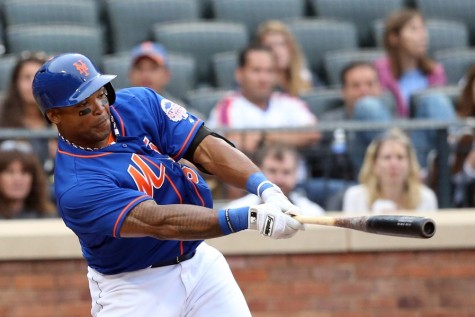
Byrd does not deny his error and he remains open about his past, which is certainly refreshing, but he has also enjoyed a remarkable resurgence as a player since that low in 2012.
“The big thing is,” Byrd said. “Why wouldn’t anybody question it? I’m 35 going on 36. Last year, I hit .210 with a home run and nine RBIs, in conjunction with testing positive.”
There would be nothing to question had Byrd not lost his effectiveness and his power in the first place. More interesting than the aftermath is the precursor — only a year after an All Star appearance Byrd’s mechanics were a shambles and his career was in a nosedive. It’s hard to imagine. You spend your life building something, a dream, a career, a livelihood, then poof, gone.
In the years leading up to 2012 Byrd earned something around 15 million over an eight year span, a virtual pittance by MLB standards. It is simply naïve to presume ballplayers will neglect to perform a simple cost / benefit analysis and conclude they’d be crazy not to try steroids when the alternative is … the abyss. In the years since his suspension Marlon Byrd has earned over 20 million dollars (although he actually earned less two years post-suspension then he did in his two years prior to — something of an outlier in this regard).
Below is a chart detailing earnings (in millions) of suspended players on the Y axis with before/after comparisons of individual players on the X. These are players for whom I was able to derive two years of salary figures both before and after a steroid suspension. I did not use players with multiple suspensions (as the consequences begin to encroach on the risks) or suspensions prior to 2012 (to coincide with MLB’s current Collective Bargaining Agreement).
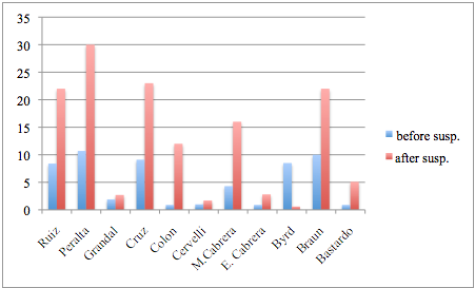
Alex Rodriguez was not included because his suspension wiped out all of his 2014 and he has not had two full years since. In all, there were 11 players and the results are eye opening. While you’d expect player salaries to rise with consideration to age and time in service, in the context of returning from a steroid suspension, the group did remarkably well even without Alex Rodriguez. In the two years leading up to suspension, suspended players earned 56.6 million, in the two years after? 137.9 million.
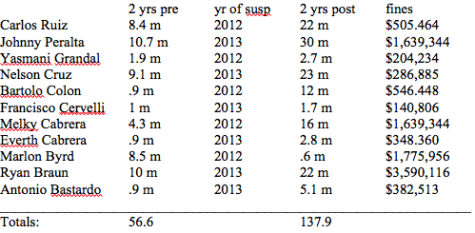
Players earned a combined 81 million more in the two years following their suspensions than they did in the 2 years leading up to them. That’s a 144% increase. I don’t know about you, but if the penalty is a 50 game suspension and the benefit is a 144% pay raise either way, pretty much a slam-dunk. Again, you’d almost have to be some kind of baseball saint to resist the temptation if the alternative is a declining skill set and a slow painful exit. We hold athletes to a standard that very few among us would uphold. The lure is simply too enormous and the punishment too feeble.
MLB on their end is certainly culpable for welcoming suspended players back with a slap on the wrist and a massive chunk of change. In the chart below we look at cumulative WAR for these same suspended players in those same four years sandwiching their suspensions, and they perform more or less up to career norms post mandated hiatus. So they are at least a safe bet, provided they stay off the juice.
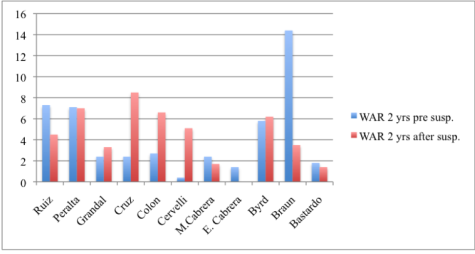
In fact, if you take Ryan Braun off the list, your post-suspension players look even better. Players like Cruz, Colon, and Cervelli saw marked improvement while most others held their own. As a fan, you have to think long and hard whether a single suspension wasn’t worth the opportunity to enjoy Cruz’s prodigious power and Colon’s wily showmanship. Sadly I believe this isn’t lost on ownership. Is it a virtual free pass for a first offense? An implement for a select few who may use it to catapult back into form? Are there lingering positive effects years later?
We know what MLB’s Drug Prevention and Treatment Program isn’t, and that’s effective.
If MLB and the MLBPA are serious about ridding the game of steroids they have to enforce a policy that will compel players to genuinely question whether dabbling in performance enhancing drugs is worth it. Presently it totally is, to the tune of a 144% pay raise — and that’s if you get caught.


